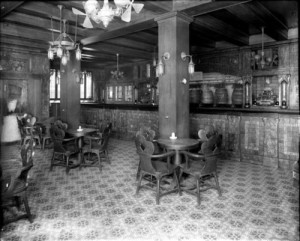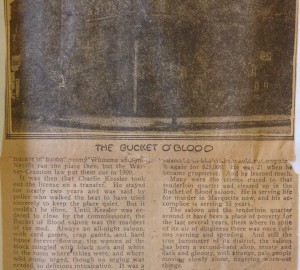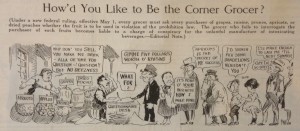The Detroit Public Library celebrates its 150th anniversary this year, with 7 million books, 21 branches, and acres of archives.* If you get a chance, be sure to check out their ongoing events and tours of the main branch, a stunning cathedral to learning that never fails to instill awe and reverence in me. It’s the sort of building that makes you want to be a better scholar yet simultaneously remains a bit intimidating. Maybe it’s the Catholic guilt instilled in me from working at Boston College’s Burns archives, or maybe it’s just the fact that I know I’m remiss in my research for the book. The thing is, I tend to over-research and under-write. I will merrily lose myself down rabbit holes that are only tangentially related to what I’m supposed to be presenting, just for the sheer joy of finding a delightful ad circa 1850, like the following:
BUY ANY OYSTERS
Jerry, at Congress Hall, has some of the finest shell oysters ever opened. He is constantly receiving fresh supplies of all kinds of shell fish, which he serves up in the very best style. It is rumored, also, that his assortment of articles in the line of ‘something to take,’ is a most excellent one, but of that we of course know nothing by actual observation.
This tiny little classified, clipped out and glued to an index card in the catalog at the library, is one of dozens of such lovingly saved ads from the 19th century. And this is only in the card catalog, not even part of the archives. But doesn’t it just make you want to stroll down Congress and Woodward and pop in to see Jerry fretting over the relative freshness of his newest shipment and concocting a refreshing punch for the parched traveler on a dusty July day? I want to belly up to that bar (not on a stool, of course, since bar stools weren’t a staple until at least 50 years after that) and find out the latest news from the east coast that accompanied these shelled wonders.

So, yeah, it’s easy for me to lose myself in research. In fact, it took me an entire afternoon just to read through the card catalog because I kept getting sidetracked by little gems like the above. No, it really doesn’t have much to do with Prohibition. But it’s pretty tough for me to resist daydreaming about what it must’ve been like to sample frog legs and turtle soup at one of the old saloons in the city. And, lest you think that the current scourge of Brooklyn-based hordes descending on Detroit in search of ruin porn, clucking their tongues at our venerable dive bars, please note that in the mid-to-late-19th century, it was a common occurrence for wealthy young folks to hook up the carriages and travel en masse to notorious slum bars such as the Bucket of Blood in search of titillating thrills. It was called a “slumming party”. They often had tour guides and police escorts for the festivities.

See? There I go again. These are just the musings inspired by the offerings in the card catalog itself. And once I got around to actually filling out request cards, the fun really started. The Burton’s cataloging system is, shall we say, quirky, so you never know what the eminently helpful research assistants will dredge up from the stacks for you. This is pretty typical of primary archival research.*
What they did bring up from the depths was fascinating, amusing…and daunting. In addition to scrapbooks and first-hand typed accounts from police officers and rumrunners, I discovered fantastic old ads like this…

…and a weekly large-format magazine from the 20s that I didn’t even know existed. It’s called Detroit Saturday Night and proves that Metro Times and Orbit magazine were hardly forerunners of Detroit social media coverage. It was all I could do not to read every single entry in the massive book I was handed. I kept catching myself poring through tongue-in-cheek accounts of wild parties unhindered by any sort of police intervention and giggling at the cartoons depicting the futility of enforcement of Prohibition. I randomly chose the volume for 1924, and the very first entry I saw, from the front page of the January 5th edition, declared the following:
Detroit was more than tolerably wide open during the holidays, according to most accounts, including those of the daily press, which specified many examples of open and wholesale public drinking in hotels, cafes, etc…It appears from the various accounts that no especial efforts were made by the police, federal enforcement officials or anyone else to stop public drinking in hotels and cafes, on New Year’s Eve. The federal agents are inclined to blame the city authorities, claiming that they themselves did not have enough men to watch public places.
Reports of the holiday drinking here, published in up-state papers, stirred new criticism of Detroit and its ways.
Ah, Detroit, ever the bane of the rest of the state’s staid, puritanical farmers and burghers. It’s good to know some things never change. Later that year, in April, the furor was all about a new law requiring grocers to inquire of their customers the intended purpose of any and all fruits purchased, in order to prevent amateur vintners from home-fermenting their own tipples. As you can imagine, this led to fruitful (pun totally intended) editorializing, limerick crafting, and this delightful cartoon:

I’m smitten. I’m allowing myself to visit the Burton collection only in small doses, liberally spaced with writing binges. Otherwise, I’d never emerge from those grand-ceilinged halls, and this darn book would never get finished.
Next up: my long-overdue account of working Ye Olde Tap Room’s Prohibition party, including the charming history of the song “No Beer No Work”. I think we can all get behind that.
* Amy Elliott Bragg’s Night Train to Detroit did a great article on the fascinating history of Clarence Burton and his passion for old books. You can read it here: Clarence Burton history. And a completely unrelated side note: Burton’s great-granddaughter drives an Uber in Detroit these days. I discovered this serendipitously recently, and she’s not only a great driver but a hoot.
**On the subject of “you never know what you’re going to get”: I spent a month in Waco, Texas at Baylor University’s Armstrong Browning Library, ostensibly researching an art historian named Anna Jameson. I received the library’s Visiting Scholars Fellowship to do this research, based on the proposal I wrote after poring through their online catalog of manuscripts. Within two days of arriving, I’d discovered that the overwhelming majority of Jameson’s correspondence and ephemera were calling cards–those little notes you leave people saying “I stopped by while you were out. Sorry I missed you. Lunch soon?” So I had to get pretty creative with the scope of the research for my remaining 28 days there. Fortunately, this is most definitely not the case with the Burton archives.
Be First to Comment